The car Transmission Bible - how transmissions and gearbox work including manuals, automatics, clutch, CVT, crash gearboxes, differentials, limited-slip differentials, 2wd, 4wd, awd and much more.
The Transmission Bible
Transmission, or gearbox?
That question depends on which side of the Atlantic you're on. To the Europeans, it's a gearbox. To the Americans, it's a transmission. Although to be truthful, the transmission is the entire assembly that sits behind the flywheel and clutch - splitting hairs, the gearbox is really a subset of the transmission.
Either way, this page aims to deal with the whole idea of getting the power from the engine to the ground in order to move the car (or bike) forwards.
Manual gearboxes - what, why and how?
From the Fuel & Engine Bible you've learned that the pistons drive the main crank in the engine so that it spins. Idling, it spins around 900rpm. At speed it can be anything up to 7,500rpm. It's not wise (or possible) to simply connect a set of wheels to the end of the crank because the speed is too high and too variable, and the engine would need to be stalled every time the vehicle came to a stop. Instead, revolutions of the crank need to be reduced down to a usable speed. This is known as gearing down - the mechanical process of using interlocking gears to reduce the number of revolutions of something that is spinning.
A quick primer on how gears work
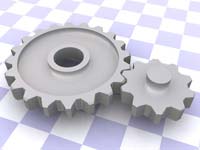
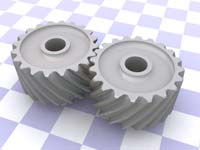
In this case we're talking about gears meaning 'toothed wheel' as oppose to gears as in 'my car has 5 gears'. A gear (or cog, or sprocket) in its most basic form is a flat circular object that has teeth cut into the edge of it. The most basic type of gear is called a spur gear, and it has straight-cut teeth, where the angle of the teeth is parallel to the axis of the gear. Wider gears and those that are cut for smoother meshing are often cut with the teeth at an angle, and these are called helical gears. Because of the angle of cut, helical gear teeth have a much more gradual engagement with each other, and as such they operate a lot more smoothly and quietly than spur gears. Gearboxes for cars and motorbikes almost always use helical gears for this reason. A side effect of helical gears is that if the teeth are cut at the correct angle - 45 degrees - a pair of gears can be meshed together perpendicular to each other. This is a useful method of changing the direction of movement or thrust in a mechanical system. Another method would be to use bevel gears.

The number of teeth cut into the edge of a gear determines its scalar relative to other gears in a mechanical system. For example, if a 20-tooth gear is meshed together with a 10-tooth gear, then spun for one rotation, it will cause the 10-tooth gear to turn twice. Gear ratios are calculated by divinding the number of teeth on the output gear by the number of teeth on the input gear. So the gear ratio here is output/input, 10/20 = 1/2 = 1:2. Gear ratios are often simplified to represent the number of times the output gear has to turn once. In this example, 1:2 is 0.5:1 - "point five to one". Meaning the input gear has to spin half a revolution to drive the output gear once. This is known as gearing up.

Gearing down is exactly the same only the input gear is now the one with the least number of teeth. In this case, driving the 10-tooth gear as the input gear gives us output/input of 20/10 = 2/1 = 2:1 - "two to one". Meaning the input gear has to spin twice to drive the output gear once.
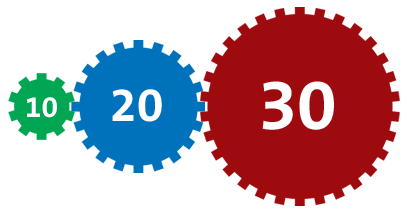
By meshing many gears together of different sizes, it is possible to create a mechanical system to gear up or gear down the number of rotations very quickly. As a final example, imagine an input gear with 10 teeth, a secondary gear with 20 teeth and a final gear with 30 teeth. From the input gear to the secondary gear, the ratio is 20/10 = 2:1. From the second gear to the final gear, the ratio is 30/20 = 1.5:1. The total gear ratio for this system is (2 * 1.5):1, or 3:1. ie. to turn the output gear once, the input gear has to turn three times.
This also neatly shows a shortcut calculation that misses the middle gear ratio - ultimately what is needed is the ratio of input to output. In this example, the final output is 30 and the original input is 10. 30/10 = 3/1 = 3:1.
Collections of helical gears in a gearbox are the process by which the speed of the engine crank is geared down to the final speed of the output shaft from the gearbox. The table below shows some example gear ratios for a 5-speed manual gearbox:
| Gear | Ratio | RPM of gearbox output shaft when the engine is at 3000rpm |
|---|---|---|
| 1st | 3.166:1 | 947 |
| 2nd | 1.882:1 | 1594 |
| 3rd | 1.296:1 | 2314 |
| 4th | 0.972:1 | 3086 |
| 5th | 0.738:1 | 4065 |
Final drive - calculating speed from gearbox ratios. It's important to note that in almost all vehicles there is also a final reduction gear. This is also called a final drive, rear-axle reduction or front-axle gear reduction. It's normally done in the differential with a small pinion gear and a large ring gear (see the section on differentials lower down the page). In the example above, the final reduction from the output shaft of the gearbox to the driveshafts coming out of the differential to the wheels is 4.444:1. In 5th gear, at 3000rpm, the gearbox output shaft spins at 4065rpm. This goes through a 4.444:1 reduction in the differential to give a wheel driveshaft rotation of 914rpm. For a typical 4 door passenger car, assume a wheel and tyre combo of 205/55R16 giving a circumference of 1.985m or 6.512ft (see The Wheel & Tyre Bible). Each minute, the wheel spins 914 times meaning it moves the car (914 x 6.512ft) = 5951ft along the ground, or 1.127 miles. In an hour, that's (60minutes x 1.127miles) = 67.62. In other words, knowing the gearbox ratios and tyre sizes, it is possible to calculate that at 3000rpm, this car will be doing 67mph in 5th gear.
Making those gears work together to make a gearbox
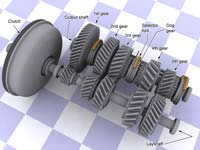
The image here shows the internals of a generic gearbox. Notice the helical gears meshing with each other. The lower shaft in this image is called the layshaft - it's the one connected to the clutch - the one driven directly by the engine. The output shaft is the upper shaft in this image. To the uneducated eye, this looks like a mechanical nightmare, but when followed through in a logcial fashion, you will be able to look at this image and say with some authority, "Ah yes, that's a 5-speed gearbox".
So how is it possible to make that statement? First, look at the output shaft. There are 5 helical gears and 3 sets of selector forks. At the most basic level, that indicates that this is a 5-speed box (note that this example has no reverse gear) But how does it work? It's actually a lot simpler than most people think although after reading the following explanation you might be in need of a brain massage.
With the clutch engaged (see the section on clutches below), the layshaft is always turning. All the helical gears on the layshaft are permanently attached to it so they all turn at the same rate. They mesh with a series of gears on the output shaft that are mounted on slip-rings so they actually spin around the output shaft without turning it. Look closely at the selector forks; they are slipped around a series of collars with teeth on the inside. Those are the 'dog gears' and the teeth are the 'dog teeth'. The dog gears are mounted to the output shaft on a splined section which allows them to slide back and forth. When the gear selector is moved, a series of mechanical pushrod connections move the various selector forks, sliding the dog gears back and forth.
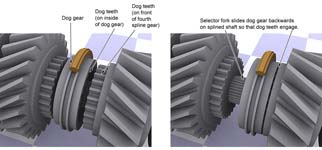
In the image to the left, I've rendered a close-up of the area between third and fourth gear. When the gearstick is moved to select fourth gear, the selector fork slides backwards. This slides the dog gear backwards on the splined shaft and the dog teeth engage with the teeth on the front of the helical fourth gear. This locks it to the dog gear which itself is locked to the output shaft with the splines. When the clutch is let out and the engine drives the layshaft, all the gears turn as before but now the second helical gear is locked to the output shaft and voila - fourth gear.
Grinding gears. In the above example, to engage fourth gear, the dog gear is disengaged from the third helical gear and slides backwards to engage with the fourth helical gear. This is why a clutch is necessary and it's also the cause of the grinding noise from a gearbox when someone is cocking up their gearchange. The common misconception is that this grinding noise is the teeth of the gears grinding together. It isn't. Rather it's the sound of the teeth on the dog gears skipping across the dog teeth of the helical output gears and not managing to engage properly. This typically happens when the clutch is let out too soon and the gearbox is attempting to engage at the same time as it's trying to drive. Doesn't work. In older cars, it required something called double-clutching.
Double-clutching, or double-de-clutching (I've heard it called both) was a process that needed to happen on older gearboxes to avoid grinding the gears. First, the clutch pedal was pressed to take the pressure off the dog teeth and allow the gear selector forks and dog gears to slide into neutral, away from the engaged helical gear. With the clutch pedal released, the engine would be 'blipped' to bring the revs up to the speed needed to engage the next gear, clutch-in and move the gear stick to slide the selector forks and dog gear to engage with the next helical gear.
The synchromesh
(or why double-clutching is no longer needed)
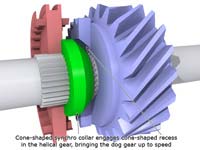
Synchros, synchro gears and synchromeshes - they're all basically the same thing. A synchro is a device that allows the dog gear to come to a speed matching the helical gear before the dog teeth attempt to engage. It matches the speeds of the various spinning gearbox components. To the left is a colour-coded cutaway part of the example gearbox. The green cone-shaped area is the syncho collar. It's attached to the red dog gear and slides with it. As it approaches the helical gear, it makes friction contact with the conical hole. The more contact it makes, the more the speed of the output shaft and free-spinning helical gear are equalised before the teeth engage. If the car is moving, the output shaft is always turning (because ultimately it is connected to the wheels). The layshaft is usually connected to the engine, but it is free-spinning once the clutch has been operated. Because the gears are meshed all the time, the synchro brings the layshaft to the right speed for the dog gear to mesh. This means that the layshaft is now spinning at a different speed to the engine, but that's OK because the clutch gently equalises the speed of the engine and the layshaft, either bringing the engine to the same speed as the layshaft or vice versa depending on engine torque and vehicle speed.
So to sum up that very long-winded description, I've rendered up an animation - seeing the parts of the gearbox moving in an animation will hopefully make more sense. What we have here is a single gear being engaged. The layshaft the blue shaft with the smaller helical gear attached to it. To start with, the larger helical gear is free-spinning on its slip ring around the red output shaft - which is turning at a different speed because it's connected to the wheels. As the gear stick is moved, the gold selector collar begins to slide the dog gear along the splines on the output shaft. As the synchromesh begins to engage with the large helical gear, the helical gear starts to spin up to speed to match the output shaft. Because it is meshed with the gear on the layshaft, it in turn starts to bring the layshaft up to speed too. Once the speed of everything is matched, the dog gear locks in place with the output helical gear and the clutch can be engaged to connect the engine to the wheels again.
What about reverse?
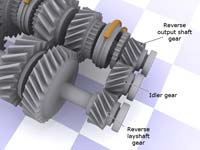
Reverse gear is normally an extension of everything learned above but with one extra gear involved. Typically, there will be three gears that mesh together at one point in the gearbox instead of the customary two. There will be a gear each on the layshaft and output shaft, with an additional small gear in between them called the idler gear. The inclusion of this extra mini gear causes the last helical gear on the output shaft to spin in the opposite direction to all the others. The principle of engaging reverse is the same as for any other gear - a dog gear is slid into place with a selector fork. Because the reverse gear is spinning in the opposite direction, when the clutch is let out, the gearbox output shaft spins the other way - in reverse. Simple. The image on the left shows the same gearbox as above, modified to have a reverse gear.
Crash gearboxes or dog boxes.
Having gone through all of that business about synchromeshes, it's worth mentioning what goes on in racing gearboxes. These are also known as crash boxes, or dog boxes, and use straight-cut gears instead of helical gears. Straight-cut gears have less surface area where the gears contact each other, which means less friction, which means less heat and less loss of power. That's why people who make racing boxes like to use them.
Normally, straight-cut gears are mostly submerged in oil rather than relying on it sloshing around like it does in a normal gearbox. So the extra noise that is generated is reduced to a (pleasing?) whine by the sound-deadening effects of the oil.
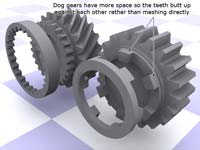
But what is a dog box? Motorbikes have been using them since the dawn of time. Beefing the system up for cars was the brainchild of a racing mechanic who wanted to provide teams with a quick method of altering gear ratios in the pits without having to play "chase the syncro hub ballbearings" as they fell out on to the garage floor.
Normal synchro gearboxes run at full engine speed as the clutch directly connects the input shaft to the engine crank. Dog boxes run at a half to a third the speed of the engine because there is a step-down gear before the gearbox. The dog gears in a dog box also have less teeth on them than those in a synchro box and the teeth are spaced further apart. So rather than having an exact dog-tooth to dog-hole match, the dog teeth can have as much as 60° "free space" between them. This means that instead of needing an exact 1-to-1 match to get them to engage, there is up to 1/6th of a rotation to get the dog teeth pressed together before they touch each other and engage. The picture on the right shows the difference between synchro dog gears and crash box dog gears.
So the combination of less, but larger dog teeth spaced further apart, and a slower spinning gearbox make for an (allegedly) easier-to-engage crash box. In reality, it's still quite difficult to engage a crash box because exactly the right rpm is needed for each gear or the dog teeth just end up grinding together or bouncing over each other. That results in metal filings in the transmission fluid, which ultimately results in an expensive and untimely gearbox rebuild.
But it is more mechanically reliable - it's stronger and able to deal with a lot more power and torque which is why it's used in racing.
So in essence, a dog box relies entirely on the driver to get the gearchange right. But does it?. Nowadays the gearboxes have ignition interrupters connected to them. As the driver goes to change gear, the ignition system in the engine is cut for a fraction of a second as the transmission comes to the point where the dog teeth are about to engage. This momentarily removes all the drive input from the gearbox making it a hell of a lot easier to engage the gears. And when I say 'momentary' I mean milliseconds. Because of this, it is entirely possible to upshift and downshift without using the clutch (except from a standstill). Pull the gear out of first, and as the throttle is blipped to get the engine to about the right speed, the ignition is cut just as the gears engage.
Even the blip of the throttle isn't necessary now either - advanced dog boxes can also attempt to modify the engine speed by adjusting the throttle input to get the revs to the right range first.
Of course even with all this cleverness, it's still possible to get nasty mechanical wear from cocked up gear changes, but in racing that doesn't matter so much - the gearbox is stripped down and rebuilt after each race.
Before the gearbox - the clutch
So now you have a basic idea of how gearing works there's a second item in the transmission that needs understanding - the clutch. The clutch is what enables a driver to change gears or sit at traffic lights without stopping the engine. A clutch is necessary because the engine is running all the time which means the crank is spinning all the time. There needs to be some way to disconnect this constantly-spinning crank from the gearbox. The clutch is composed of three basic elements; the flywheel, the pressure plate and the clutch plate(s). The flywheel is attached to the end of the main crank and the clutch plates are attached to the gearbox layshaft using a spline. Look at the diagrams to understand the next bit because there are some other items involved in the basic operation of a clutch. (I've rendered the clutch cover in cutaway in the first image to expose the inner components.) So here we go.
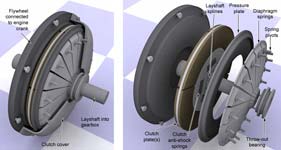
In the diagram here, the clutch cover is bolted to the flywheel so it turns with the flywheel. The diaphragm springs are connected to the inside of the clutch cover with a bolt/pivot arrangement that allows them to pivot about the attachment bolt. The ends of the diaphragm springs are hooked under the lip of the pressure plate. So as the engine turns, the flywheel, clutch cover, diaphragm springs and pressure plate are all spinning together.
The clutch pedal is connected either mechanically or hydraulically to a fork mechanism which loops around the throw-out bearing. When the clutch pedal is pressed, the fork pushes on the throw-out bearing and it slides along the layshaft putting pressure on the innermost edges of the diaphragm springs. These in turn pivot on their pivot points against the inside of the clutch cover, pulling the pressure plate away from the back of the clutch plates. This release of pressure allows the clutch plates to disengage from the flywheel. The flywheel keeps spinning on the end of the engine crank but it no longer drives the gearbox because the clutch plates aren't pressed up against it.
As the pressure is released on the clutch pedal, pressure is released on the throw-out bearing too and the diaphragm springs begin to push the pressure plate back against the back of the clutch plates, in turn pushing them against the flywheel again. Springs inside the clutch plate absorb the initial shock of the clutch touching the flywheel and as the clutch pedal is released completely, the clutch is firmly pressed against it. The friction material on the clutch plate is what grips the back of the flywheel and causes the input shaft of the gearbox to spin at the same speed.
Burning a clutch
You might have heard people using the term 'burning your clutch'. This is when the clutch pedal is held in a position such that the clutch plate is not totally engaged against the back of the flywheel. At this point, the flywheel is spinning and brushing past the friction material which heats it up in much the same was as brake pads heat up when pressed against a spinning brake rotor (see the Brake Bible). Do this for long enough and it'll smell because it burns off the friction material. This can also happen unintentionally by resting a foot on the clutch pedal in the course of normal driving. That slight pressure can be just enough to release the diaphragm spring enough for the clutch to occasionally lose grip and burn.
A slipping clutch
The other term you might have heard is a 'slipping clutch'. This is a clutch that has a mechanical problem. Either the diaphragm spring has weakened and can't apply enough pressure, or more likely the friction material is wearing down on the clutch plates. In either case, the clutch is not properly engaging against the flywheel. Under heavy load, such as accelerating in a high gear or up a hill, the clutch will disengage slightly and spin at a different rate to the flywheel. This will be felt as a loss of power, or be recognised as the engine revs rise but the car doesn't continue to accelerate. Do this for long enough and it results in the above - a burned out clutch.
Let's not forget that transmission is the most complicated component in a vehicle and it is enough to have one defective component to cause a lot of serious problems. That's why it is so important to have everything fixed and replaced in time: high performance manual and automatic transmissions, clutch sets and torque converters, and much more. If you're looking for the good place to do some shopping online, Performance Transmission Parts section at CARiD.com seems to be a great option. Dont wait another moment and choose from the great variety of components they offer for your transmission
Like the site? The page you're reading is free, but if you like what you see and feel you've learned something, a small donation to help pay down my car loan would be appreciated. Thank you.
Motorcycle 'basket' clutches
It's worth spending a moment here to talk about basket clutches as found on some Yamaha motorbikes. Even though the basic principle is the same (sandwiching friction-bearing clutch plates against a flywheel), the design is totally different. If nothing else, a quick description of basket clutches will show that there's more than one way to decouple the a spinning crank from a gearbox.
Basket clutches need to be compact to fit in a motorbike frame so they can't have a lot of depth to them. They also need to be readily accessible for mechanics to be able to service them with the minimum amount of fuss, something that's near impossible with regular car clutches. A basket clutch has a splined clutch boss bolted to the shaft coming from the engine crank with strong springs. Metal pressure plates slide on to this shaft, in alternating sequence with friction material clutch plates. The clutch plates are splined around the outside edge, where they fit into slots in an outer basket - the clutch housing. The clutch housing is bolted on to the layshaft which runs back through the middle of the whole mechanism and into gearbox. Clever, but as usual, not much use without a picture, so here's one to help:
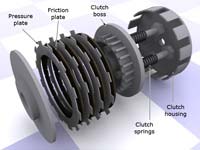
In operation, a basket clutch is simplicity itself. A throw-out bearing slides around the outside of the layshaft and when the clutch lever is pulled, the throw-out bearing pushes against the clutch boss. The clutch boss compresses the clutch springs and removes pressure from the whole assembly. The friction plates now spin freely in between the pressure plates. When the clutch is let out, the springs push the clutch boss in again and it re-asserts the pressure on the system, crushing the friction and pressure plates together so they grip. Voila. Clutch type number two.
You should now feel proud that with all your newfound (and somewhat geeky) understanding of clutches, you can go about your business safe in the knowledge that you sort of understand how all this spinning, geared-and-splined witchcraft works.
